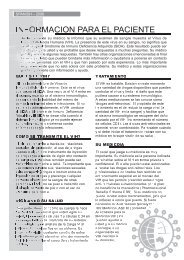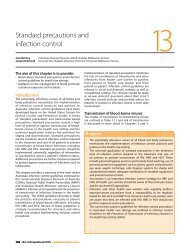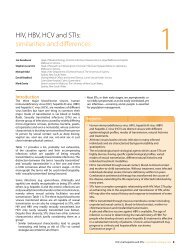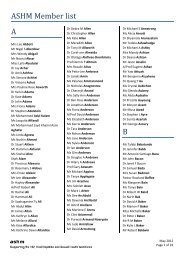B Positive – all you wanted to know about - ASHM
B Positive – all you wanted to know about - ASHM
B Positive – all you wanted to know about - ASHM
Create successful ePaper yourself
Turn your PDF publications into a flip-book with our unique Google optimized e-Paper software.
5 Primary prevention of hepatitis B virus infection<br />
be given, as a fourth double dose or further<br />
three doses at monthly intervals, followed by<br />
testing for response four weeks later. Persistent<br />
non-responders should be informed <strong>about</strong> the<br />
need for HbiG within 72 hours of parenteral<br />
exposure <strong>to</strong> HbV.<br />
Vaccination failure may occur in people<br />
exposed <strong>to</strong> HbV variants with mutations<br />
in the HbV surface gene (vaccine-induced<br />
escape mutant). current HbV vaccines are not<br />
effective in preventing infection with these<br />
mutants. the majority of such vaccine-induced<br />
escape mutants were initi<strong>all</strong>y reported in<br />
neonates through vertical transmission and in<br />
transplant recipients. these vaccine-induced<br />
escape mutants were responsible for most of<br />
the 3.4% vaccine failure rate reported in the<br />
chinese adult population undergoing an HbV<br />
vaccination program. 10<br />
HBV vaccination programs in the<br />
CALD and Indigenous populations<br />
caLd and indigenous populations are<br />
confronted with different issues from the<br />
general population, which often hamper the<br />
success of vaccination programs in australia.<br />
Language and cultural differences are obvious<br />
barriers. People not captured by the universal<br />
infant and adolescent vaccination program<br />
can present, related <strong>to</strong> their age at migration<br />
<strong>to</strong> australia. some practices transferred <strong>to</strong><br />
australia, such as eyebrow tat<strong>to</strong>oing and<br />
vacuuming (a form of therapy involving the<br />
use of suction cups applied <strong>to</strong> the skin), could<br />
continue <strong>to</strong> be routes of transmission.<br />
the high prevalence rate of HbV infection in<br />
the indigenous population requires targeted<br />
public health policies <strong>to</strong> overcome the barriers<br />
<strong>to</strong> accessing public health education and<br />
medical services.<br />
for further information <strong>about</strong> these<br />
recommendations, please refer <strong>to</strong> The Australian<br />
Immunisation Handbook. 9th edition (2007). 11<br />
References<br />
50 b <strong>Positive</strong> <strong>–</strong> <strong>all</strong> <strong>you</strong> <strong>wanted</strong> <strong>to</strong> <strong>know</strong> <strong>about</strong> hepatitis b: a guide for primary care providers<br />
1. Kao JH, Hsu HM, shau Wy, chang MH, chen<br />
ds. universal hepatitis b vaccination and the<br />
decreased mortality from fulminant hepatitis in<br />
infants in taiwan. J Pediatr 2001;139:349-52.<br />
2. Heymann dL, edi<strong>to</strong>r. control of communicable<br />
diseases manual. 18th ed. Washing<strong>to</strong>n:<br />
american Public Health association, 2004.<br />
3. Goldstein s, fiore a. <strong>to</strong>wards the global<br />
elimination of hepatitis b virus transmission. J<br />
Pediatr 2001;139:343-5.<br />
4. ni yH, Huang LM, chang MH, yen cJ, Lu<br />
cy, <strong>you</strong> sL, et al. two decades of universal<br />
hepatitis b vaccination in taiwan: impact<br />
and implication for future strategies.<br />
Gastroenterology 2007:132(4):1287-93.<br />
5. o’sullivan bG, Gidding Hf, Law M, Kaldor<br />
JM, Gilbert GL, dore GJ. estimates of chronic<br />
hepatitis b virus infection in australia, 2000.<br />
aust n Z J Public Health 2004;28(3):212-6.<br />
6. Williams a. reduction in the hepatitis b<br />
related burden of disease-measuring the<br />
success of universal immunisation programs.<br />
commun dis intell 2002;26:458-60.<br />
7. saari tn for the american academy of<br />
Pediatrics committee on infectious diseases.<br />
immunization of preterm and low birth<br />
weight infants. Pediatrics 2003;112:193-8.<br />
8. duclos P. safety of immunisation and<br />
adverse events following vaccination against<br />
hepatitis b (review). expert opin drug saf<br />
2003;2(3):225-31.<br />
9. World Health organization (WHo). the<br />
Global advisory committee on Vaccine<br />
safety rejects association between hepatitis<br />
b vaccination and multiple sclerosis (Ms).<br />
2006. available at: http://www.who.int/<br />
vaccine_safety/<strong>to</strong>pics/hepatitisb/ms/en/<br />
(Last accessed oc<strong>to</strong>ber 2006).<br />
10. chuan He, fumio nomura, sakae i<strong>to</strong>ga,<br />
Kazumasa isobe, <strong>to</strong>shiaki nakai. Prevalence<br />
of vaccine-induced escape mutants of<br />
hepatitis b virus in the adult population in<br />
china: a prospective study in 176 restaurant<br />
employees. J Gastroenterol Hepa<strong>to</strong>l 2001:16<br />
(12); 1373<strong>–</strong>7.<br />
11. national Health and Medical research<br />
council (nHMrc). the australian<br />
immunisation Handbook. 9th edition.<br />
canberra: commonwealth department of<br />
Health and ageing, 2007.






